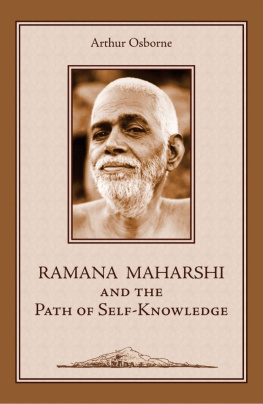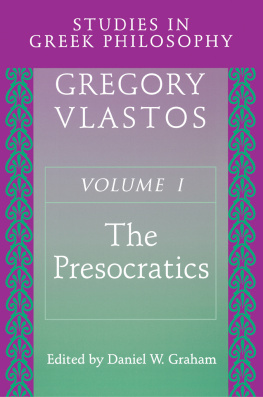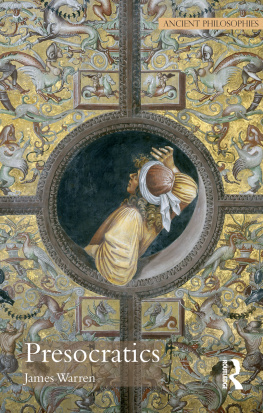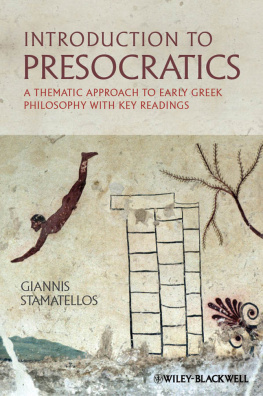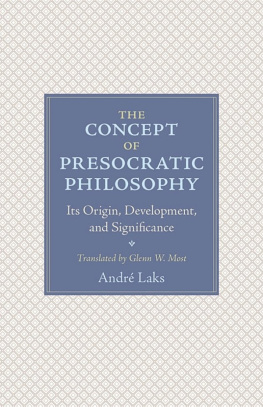Presocratic Philosophy: A Very Short Introduction
Catherine Osborne
PRESOCRATIC PHILOSOPHY
A Very Short Introduction


Great Clarendon Street, Oxford OX2 6DP
Oxford University Press is a department of the University of Oxford. It furthers the Universitys objective of excellence in research, scholarship, and education by publishing worldwide in
Oxford New York
Auckland Bangkok Buenos Aires Cape Town Chennai Dar es Salaam Delhi Hong Kong Istanbul Karachi Kolkata Kuala Lumpur Madrid Melbourne Mexico City Mumbai Nairobi So Paulo Shanghai Taipei Tokyo Toronto
Oxford is a registered trade mark of Oxford University Press in the UK and in certain other countries
Published in the United States
by Oxford University Press Inc., New York
Catherine Osborne, 2004
The moral rights of the author have been asserted
Database right Oxford University Press (maker)
First published as a Very Short Introduction 2004
All rights reserved. No part of this publication may be reproduced, stored in a retrieval system, or transmitted, in any form or by any means, without the prior permission in writing of Oxford University Press, or as expressly permitted by law, or under terms agreed with the appropriate reprographics rights organizations. Enquiries concerning reproduction outside the scope of the above should be sent to the Rights Department, Oxford University Press, at the address above
You must not circulate this book in any other binding or cover and you must impose this same condition on any acquirer
British Library Cataloguing in Publication Data
Data available
Library of Congress Cataloging in Publication Data
Data available
ISBN 13: 9780192840943
ISBN 10: 0192840940
3 5 7 9 10 8 6 4 2
Typeset by RefineCatch Ltd, Bungay, Suffolk
Printed in Great Britain by
TJ International Ltd., Padstow, Cornwall
Contents
List of illustrations
Mummy case portrait mask of a young woman, from Roman Egypt (1st to 2nd century AD)
Christies/Werner Forman Archive
Papyrus scraps from Strasbourg
LInstitut de Papyrologie de Strasbourg/Bibliothque nationale et universitaire de Strasbourg
Ensemble a from the reconstruction of the Strasbourg Papyrus
Bibliothque nationale et universitaire de Strasbourg
Ensemble d from the reconstruction of the Strasbourg Papyrus
Bibliothque nationale et universitaire de Strasbourg
Temple of Hera at Agrigento
TopFoto.co.uk
Mount Etna
TopFoto.co.uk
The alternation of love and strife
Minotaur depicted on the black-figure interior of an Attic bilingual cup (c.515 BC)
Christies/Werner Forman Archive
Vase depicting Sarpedon (early 5th century BC)
The Louvre. Photo RMN/Herv Lewandowski
Miletus
Alan Greaves, University of Liverpool
Detail of The School of Athens (150911) by Raphael
Vatican Museums. Alinari Archives/Corbis
Crossroads
Images.com/Corbis
How can Achilles catch the tortoise?
How can the runner move from A to B?
Bendis on an Attic red-figure cup (430420 BC)
Antikensammlung des Archologisches Instituts, Tbingen
A warrior and his two black squires, Athenian black-figure vase, painted by Exekias
British Museum
Statuette of Taweret, Egyptian goddess of fertility (c.664610 BC)
Egyptian Museum, Cairo/Werner Forman Archive
Democritus by Antoine Coypel (16611722)
The Louvre. Photo RMN/Herv Lewandowski
Electron microscope image of the fossilized shell of a tiny ocean animal
Dee Breger
Jacobs Ladder (c.1800) by William Blake
British Museum/Bridgeman Art Library
The River Caster at Ephesus
From Dietram Muller, Topographischer Bildkommentar zu den Historien Herodotos
Symposiasts with lyres, scene on Attic red-figure rhyton
Virginia Museum of Fine Arts, Richmond. The Adolph D. and Wilkins C. Williams Fund. Photo: Katherine Wetzel
Vase depicting animal sacrifice
The Louvre. Photo RMN/Chuzeville
Diagram of Pythagorass theorem
Political rhetoric or democracy
Jean Michel [www.isle-sur-sorgue-antiques.com]
Death of Socrates (1780) by Watteau
Muse des Beaux-Arts, Lille. Photo RMN/P. Bernard
Athletes exercising, on Attic red-figure kylix, attributed to the Carpenter Painter (c.515510 BC)
J. Paul Getty Museum, Malibu, California
The Rape of Helen (date unknown) by Johann Georg Platzer
Wallace Collection/Bridgeman Art Library
The publisher and the author apologize for any errors or omissions in the above list. If contacted they will be pleased to rectify these at the earliest opportunity.
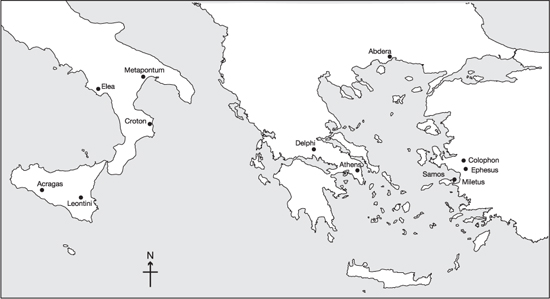
Home cities of chief Presocratic Philosophers
Time line A Presocratic Philosophers and Plato and Aristotle, showing approximate dates of writing and/or teaching
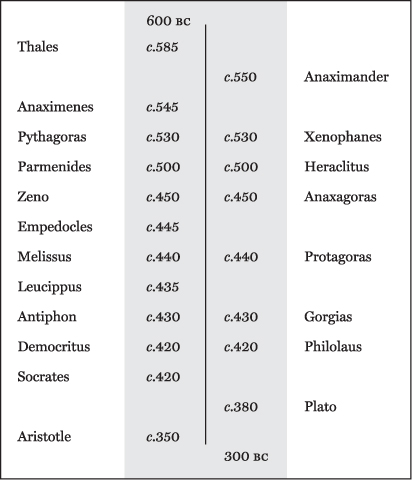
Time line B Writers of the first six centuries AD who quote from the Presocratic Philosophers
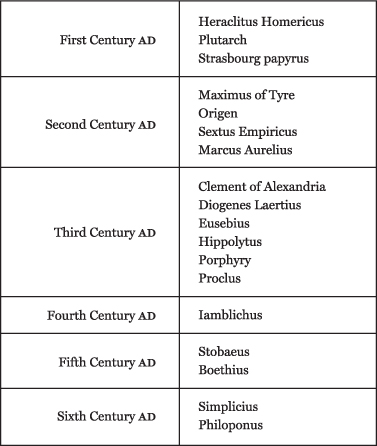
A note on the pronunciation
This book is full of men whose names end in...es. The e in this last syllable is always pronounced (it is not a silent e) and it is always long, so that the last syllable of these names rhymes with please. This may be familiar to you from the name Socrates. In all our examples, Thales, Anaximenes, Empedocles, Parmenides, the ending is pronounced in this way.
It is traditional to anglicise the pronunciation of Greek names in accordance with long-established custom, by making the vowels that are long in Greek long in English: thus Thales has a long a (as in came) and Pythagoras has a long y (as in fly), Zeno has a long e as in theme and a long o as in tome, Heraclitus has a long i as in pie. Most of the other vowels are short.
There are a few exceptions to the long-vowel-rule: the first e in Heraclitus should be long: some people do say hear-a-cli-tus but most people pronounce it short; and the first o in Socrates should be long but it is standardly shortened in English.
The following chart shows where the stress is placed in English pronunciation of the main names (stress the accented vowel):
Thles
Empdocles
Xenphanes
Protgoras
Parmnides
Cllicles
Melssus
Anaxmenes
Demcritus
Heracltus
Scrates
ntiphon
Anaximnder
Anaxgoras
Pythgoras
Grgias
Zno
Introduction
Before computers were invented people published their thoughts as printed marks in books. Before printing was invented their written thoughts were laboriously copied by hand into codices. Before codices were invented they made their marks on rolls of papyrus or engraved them on stone, on wax blocks, or in the sand. Before writing was invented they sang songs and entertained each other with the telling of tales, tales of how the heroes fought at Troy, how the giants fought the gods, how the earth brought forth living things, and where the dead go when they are no longer seen.
Next page



